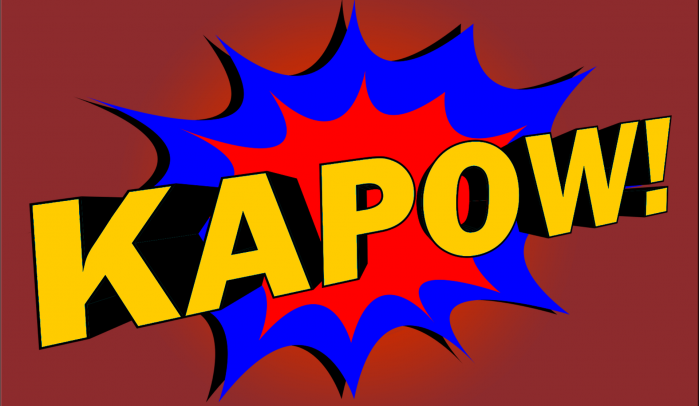UPDATED MARCH 16, 2023
Yes, copywriters use jargon too
It’s ironic when you think about it.
We copywriters spend our days telling clients to keep it simple and ditch the jargon — yet we still have some jargon of our own. Talk about double standards!
If you’re unfamiliar with some of the terms you’ve seen copywriters using, keep reading.
I’ve compiled this list of the copywriting and SEO copywriting terminology you might encounter when we work together — and I’ve explained what it all means.
A glossary of copywriting terminology
A/B Split testing
Unfortunately there’s no guaranteed formula for writing the perfect piece of copy, so a lot of copywriting is following best practice and seeing what sticks. But in some cases you can test your copy to see how it performs — and that’s where A/B split testing comes in.
A/B split testing is when a copywriter creates two different versions of their copy and tests them to see which one gets the best results.
Let’s say a copywriter is creating an email campaign. The subject line for the email is critical and can be the difference between a prospect opening the email or not.
The copywriter will write several versions of the subject line, then narrow those down to what they think are the two best options. We’ll call those subject lines A and B.
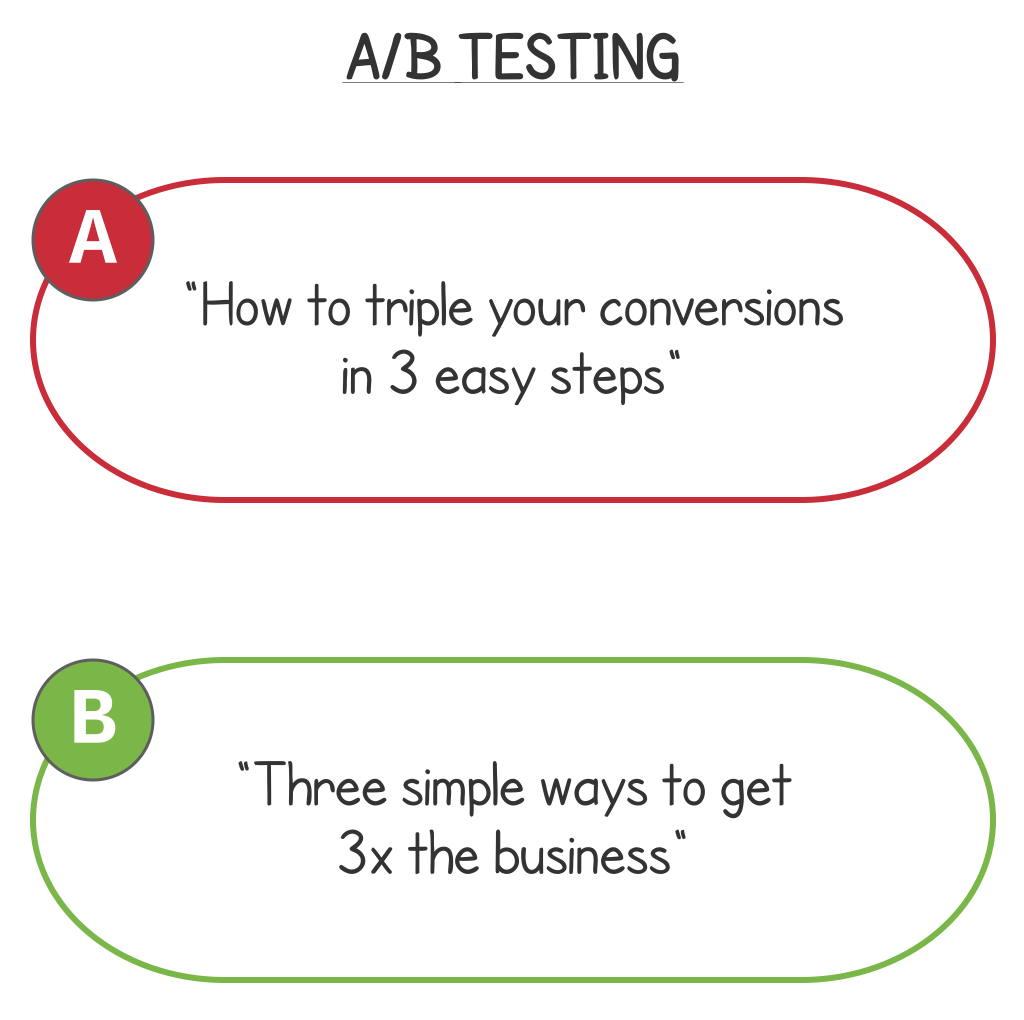
In an A/B split test, the copywriter will send their email to a sample of the full mailing list. Half of the sample will get subject line A and the other half will get subject line B.
Whichever subject line gets the highest open rate will be sent to the remainder of the mailing list.
You can use A/B split testing to assess a variety of direct response communications, including ads, landing pages and leaflet drops.
Above the fold/Hero section
Above the fold, also known as the Hero section, is the section at the very top of a web page. It’s the part you see on screen when a website first loads and before you start scrolling down.
First impressions are everything — and you don’t want to lose visitors as soon as they arrive — so getting this section right is crucial!
Essentially, the section above the fold needs to:
- Be well-designed and nice to look at
- Reassure your visitor they’ve come to the right place
- Give your visitor a reason to scroll down and see more
- Explain who you are, what you do, who you do it for, and why they should care about it.
Active voice
Active voice refers to the grammatical construction of a sentence or piece of copy.
Active voice is clear and direct. And it sounds involved and engaged, which makes it ideal for informal and conversational copy.
When you use active voice in a sentence, the doer always comes before the thing that’s being done.
For example, in the following sentence, the cat is the doer and knocking over the glass of milk is the thing that’s being done.
Active voice example:
The cat knocked over the glass of milk.
The opposite of active voice is passive voice.
Passive voice example:
The glass of milk was knocked over by the cat.
You’ll find a full discussion about both, with more examples, in my article: What’s the difference between active and passive voice? >>
Advertorial
An advertorial is a long-form advertising feature in a magazine or newspaper.
It’s called an advertorial because it looks like an editorial article and is often written in a journalistic style. But somewhere on the page, there’ll be a disclaimer to say it’s actually an advertisement.
AI writers
AI stands for Artificial Intelligence, which is another term for robots or machines.
AI writers are being sold as an alternative to human writers. They can produce written content in minutes and at a fraction of the cost of a person.
But are they any good?
Well, that is the question.
Here are 17 Reasons NOT to rely on AI writers for your business copywriting >>
Anchor links
An anchor link is an internal website link that takes you to a straight to specific point on a web page.
It might jump to a different point of the page you’re already on or take you to a specific point on another page of the website.
For example, if you were reading one of my other articles and there was an anchor link to an explanation of anchor links, it would bring you straight to this point on this page. Clever, huh?
Audience
Your audience is the people who’ll be reading your copy or content.
And you might have different audiences depending on who you’re targeting/talking to.
For example, your audience might be:
- Prospects (people you want to sell to)
- Clients (people you already provide services to)
- Customers (people you already sell products to)
- Users (people who are using your product or service)
- Visitors (people visiting your website).
Technically, any business can be producing communications for two or more different audiences.
In copywriting, knowing your audience is vital. It determines the way we talk to them, the language we use and the information we provide.
Awareness levels
Different members of your audience will be at different stages of their customer journey and will have different levels of awareness. Some will be more aware of what you can do for them than others. Writing for these different awareness levels is key to exploring the full potential of your market.
Legendary copywriter, Eugene Schwartz, came up with these 5 Stages of Awareness. The five stages go from Unaware to Most Aware, like this:
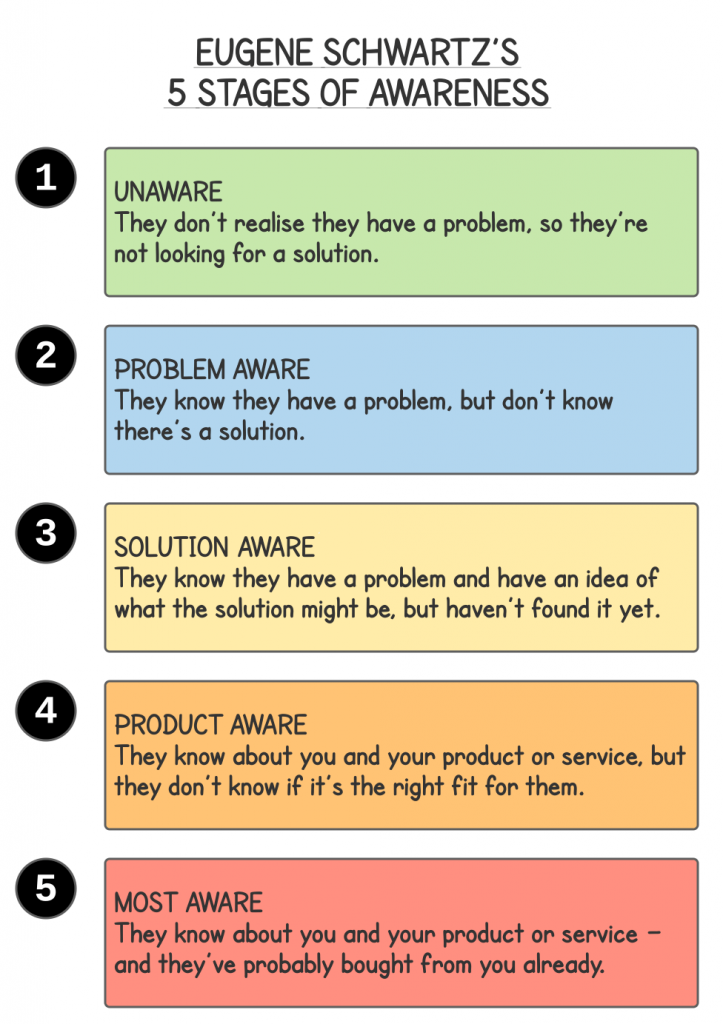
You’ll find a more in-depth guide to the different awareness levels and how we create content for each one in my article: How does blogging work for your business >>
B2B copywriting
B2B stands for Business to Business. This is the copywriting you need if you’re a business and your customer is also a business.
It’s important to distinguish B2B copywriting from B2C copywriting, as it requires a different approach. When businesses make purchases they tend to be less emotional and more considered. The copy usually needs to satisfy several interested parties that the purchase is a good idea.
B2C copywriting
B2C stands for Business to Consumer. This is the copywriting you need if you’re selling direct to consumers.
Consumer purchases can be more impulsive and emotional than business purchases. They can also be based on desires rather than needs.
Backlinks
A backlink is a link to a page of your website that comes from a different website.
For example, if one of your customers talks about one of your products in their blog, they might include a backlink to that particular product page.
If you’d like to find out more, you can read my article: A beginner’s guide to backlinks and link-building >>
Benefits
Laying out the benefits of your product or service will show your readers how it will make them or their lives better. For example, your product might:
For example if you’re selling vacuum cleaners, your feature/benefit breakdown might be:
- Feature: Powerful 1000W motor
- Benefit: Cleans your carpets in half the time
- Benefit: Removes stubborn pet hair and microscopic allergens you can’t see
- Benefit: Offers a deep clean that gets right down into the fibres of the carpet.
You can read more about benefits in my article: Features vs. benefits and how copywriters use them to sell >>
Black hat SEO
Black hat SEO refers to dodgy and ill-advised SEO practices. SEOs who use these practices try to game Google’s algorithm to get websites to the top of the rankings.
Examples of black hat SEO include keyword stuffing and article spinning.
If an SEO promises you amazing results quickly, they’ll probably be using black hat techniques to get them.
The results are often short-lived and could get your website penalised by Google, which will make it much harder to rank in the future.
Blog
A blog is the name for the section of a website where blog articles are written and stored.
Blog articles
Blog articles, also known as blog posts, are articles written for your website and stored on your blog.
Blog articles are a form of content marketing and can fulfil a number of objectives, including:
- Using SEO keywords to draw more visitors to your website
- Promoting your expertise and authority in your field
- Building interest and trust in your brand
- Giving your reader the answers, information or advice they’re looking for
- Encouraging readers to sign up for your mailing list
- Persuading readers who might be ready to buy.
Blog categories and tags
The articles on a blog are typically organised by category. And each category is typically one of the main subjects you write about.
You can see the categories on my blog in the picture below. Your visitors will use them to find articles on the subjects they want to read about.
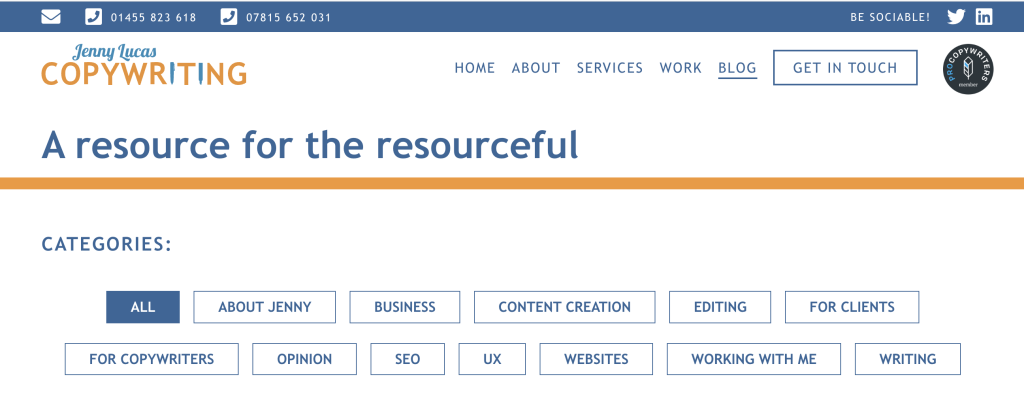
Tags are additional labels you can add to your articles. These don’t appear on the main blog page like the categories do, but they’re attached to each individual post and may be searchable.
Each article can be assigned more than one category and have multiple tags.
Body copy/body text
Body copy, or body text, is the main word content in a piece of copy or content, excluding the headline, headings, call-outs and other copy features. In this article, the body copy is what you’re reading now.
Bounce rate
Bounce rate was a term used in Google’s Universal Analytics.
It referred to the percentage of visitors who come to your website, then leave without visiting any other pages.
In GA4, which is the most current version of Google Analytics, the bounce rate metric disappeared and was replaced with something called engagement rate.
You can read more about bounce rates and engagement rates in my article: What causes a low engagement rate in GA4? >>
Brand
Copywriters talk a lot about brand. In simple terms, it comprises all the things that make your business identifiable to your prospects and customers.
For example, your:
- Visual branding (corporate colours, logo, fonts)
- Tone of voice (the way your copy sounds)
- Core values
- Personality
- Style.
Brand mission
Your brand mission refers to the practical steps you’re taking to achieve your brand vision.
Brand values
Your brand values are the heart of your business. They represent what’s important to you and what your business stands for. They should be true and authentic to your business and be a consideration in everything you do.
Having distinct brand values can set you apart from your competitors and help you attract the ideal customers you want to sell to or work with.
Some examples of brand values might be:
- Enthusiasm
- Integrity
- Originality
- Perseverance
- Warmth.
Brand vision
Your brand vision is your vision for the future and the main goal for your business.
It’s the big thing you want to achieve, the big change you want to make, and the thing you want to be known for in your industry.
Broken link
A broken link on a website is a link to a page that can no longer be found. If a user clicks on a broken link, they’ll usually be redirected to an error 404 page.
Google doesn’t like broken links, so it pays to avoid having them on your site.
Broken links happen when pages are changed, moved or deleted. So if you’re planning any modifications to your site, make sure you bear this in mind and implement redirects where necessary.
If you want to check for broken links on your own website, you can use this free broken link checker.
CSS: Cascading Style Sheet
CSS is a system that’s built into a website to control the visual style. For example, an effective CSS will ensure that the body text and headings on each of your pages are set to a consistent size, typeface and colour.
Keeping your style consistent gives a more fluid user experience and makes your website look more professional.
CTA: Call To Action
The CTA is where we prompt your reader to take action. That might be:
- Buy now
- Get in touch with us
- Sign up to our mailing list
- Download our free ebook.
CTR: Click Through Rate
The CTR refers to the percentage of people who click on a link. This could be a link on a web page, in a blog article or in an email.
For example, when copywriters write email sequences, each email usually includes a clickable link to a page of your website. This might be to promote a particular product, service or blog article.
The CTR measures the percentage of recipients who clicked on that link.
CTV: Call To Value
A CTV is a CTA with benefits!
Where a Call to Action just prompts your reader to take action, a Call to Value prompts them to take action and tells them why they should.
For example:
CTA: Buy now
CTV: Buy now for instant peace of mind
CTA: Sign up to our mailing list
CTV: Sign up now and start getting more business from LinkedIn, with daily tips straight to your inbox️
CTA: Start your free trial
CTV: Start your free trial and start creating beautiful social media posts today.
Call out
A call out is a panel that’s set apart from the rest of the text to highlight a particular piece of information.
In the diagram below, the call out appears in a blue box within the body text:
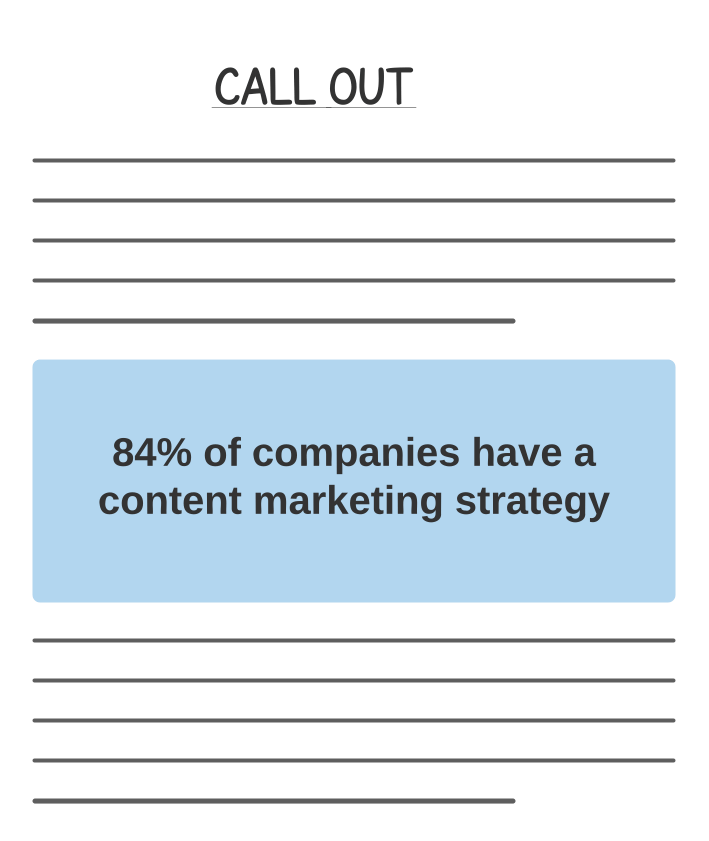
Case study
A case study is a detailed examination of a real-life project a business undertook and the result they delivered to their client.
It tells the story of the project and, like any good story, has a beginning, middle and end.
The beginning sets the scene with:
- Who the client is and any relevant background information
- What their problems were and why they needed the project.
The middle talks about:
- The project brief and what the client wanted
- How the business responded to the client’s request
- How the project was delivered
- Any problems or challenges and how they were overcome.
The end is about the finished result and:
- How it looks/works
- How it’s integrated into the client’s existing setup
- How it meets or exceeds the client’s needs
- How it’s changed their life and what difference it’s made.
The case study usually ends with a testimonial from the client.
You can read more about case studies in my article: Why case studies are like magic for your business >>
Clients/customers
These are the people you’re already working with or selling to.
Content
Content writers write content.
Content is written to build awareness of your business. And to inform, educate, entertain and inspire your audience. Your content might include:
- Blog articles
- Ebooks
- Lead magnets
- Email sequences
- Social media posts.
Although content can nudge your audience towards a sale, this is not its main goal.
Content calendar
A content calendar is used to plan out your content over a period of time, so we know what content is needed and when. Your full calendar could include a range of content including blog articles and email sequences.
Content hubs
A content hub, or topic cluster, is a collection of blog articles and other online materials that focus on a central topic.
The articles are brought together via a main ‘pillar’ article, which introduces and links to each one.
A simple content hub might look something like this:
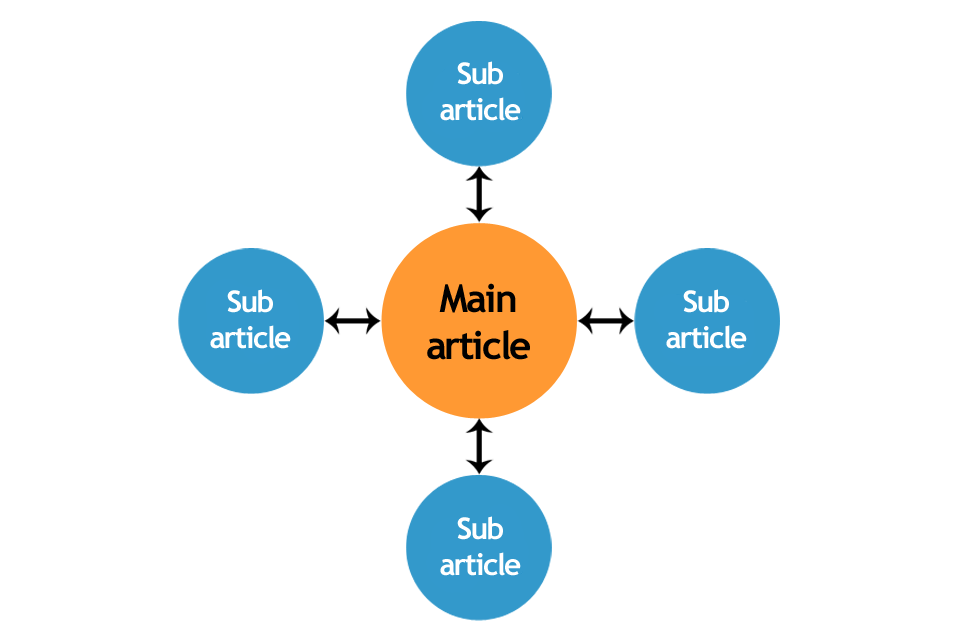
You can learn more about content hubs in my article: Content hubs: What are they and why should you be using them? >>
Content marketing
Content marketing is a marketing strategy where we focus on producing content that’s valuable to your audience and will draw them to your website.
For example, your content might include:
- Answers to questions your audience is asking Google
- Inspiration and ideas they’re looking up online
- The how-to guides they need to perform a task
- Objective advice to solve a problem or help with a purchasing decision.
The content you create should help potential customers by giving them the information and inspiration they need. So they’ll buy from you when they’re ready and if what you’re selling is right for them.
Content spinning
Content spinning, is where an unscrupulous content provider takes a professionally written article and puts it through an online tool that rewrites it hundreds or thousands of times. They then take those rewritten ‘spun’ articles and sell them to unsuspecting buyers as original content.
The online tools are basic, especially the cheap ones, and rather than rewriting the articles, they tend to keep the same structure and replace individual words with a thesaurus substitutions. As you can imagine, the quality is terrible.
Content spinning is a form of black hat SEO, which Google doesn’t tolerate — so be warned!
Conversational copy
Conversational copy is written in the same way you would speak to someone if you were having a conversation. It can be fun or serious, but it’s usually friendly, informal and personality-driven.
Most brands use some form of conversational copy.
Conversion
When we write a piece of copy or content, we always have a goal — something we want the reader to do. That might be to visit another page of a website, pick up the phone or download a lead magnet.
When the reader does the thing we want them to do, we call it a conversion.
Conversion rate
Your conversion rate shows the number of conversions you had as a percentage of the total number of people who were targeted by or exposed to your content.
For example, let’s say you do a leaflet drop with 100 leaflets and the leaflets are printed with a special promo code. If 30 people call you quoting the leaflet promo code, your conversion rate for the leaflet drop will be 30%.
Your actual conversion rate can sometimes be higher, because some people will save your communication until they’re ready to buy.
Copy
Copywriters write copy. This is the name we use for the words we write to market and sell your products or services.
You might hear us use it when we talk about:
- The type of copy in a publication (headline copy, body copy)
- The function of the copy (sales copy, marketing copy)
- Where the copy is going to be used (web copy, brochure copy, ad copy).
Copywriting brief
If you’re working with a copywriter, they should ask you to complete a copywriting brief.
The brief is a document filled with questions about your:
- Business
- Brand
- Project
- Audience
- Competitors
- Ideal customers.
It will also look at your goals and what you want to achieve.
The answers you give in the brief will give your copywriter a good starting point for researching further and creating the kind of copy that meets your audience’s needs.
Cornerstone content
Cornerstone content is the content that’s most valuable for your audience — and, in turn — your business.
This is the content you most want to rank for on Google, because it has the potential to bring in a lot of traffic.
CRO: Conversion Rate Optimisation
Conversion Rate Optimisation is the process of optimising a web page so it converts more visitors into subscribers and paying customers.
Direct response copywriting
Direct response copywriting is what you need if you want your reader to take action quickly.
This action might include:
- Making a purchase
- Signing up to your mailing list
- Downloading a lead magnet
- Registering for a course or webinar
- Following you on social media.
E-E-A-T: Experience Expertise, Authority and Trust
Experience, Expertise, Authority and Trust are four factors that Google looks for when it rates and ranks your website. The better your website can demonstrate these three traits, the higher your website should rank.
You can learn more about how to make sure your website exhibits these traits in my article: Practical ways to demonstrate E-E-A-T >>
Email drip campaign
An email drip campaign is a series of emails you send to customers on your mailing list with the intention of enticing them to become customers. A drip campaign is easy to set up and is suitable for all email subscribers.
Here’s an example of a five-email drip campaign, starting with the first welcome email:
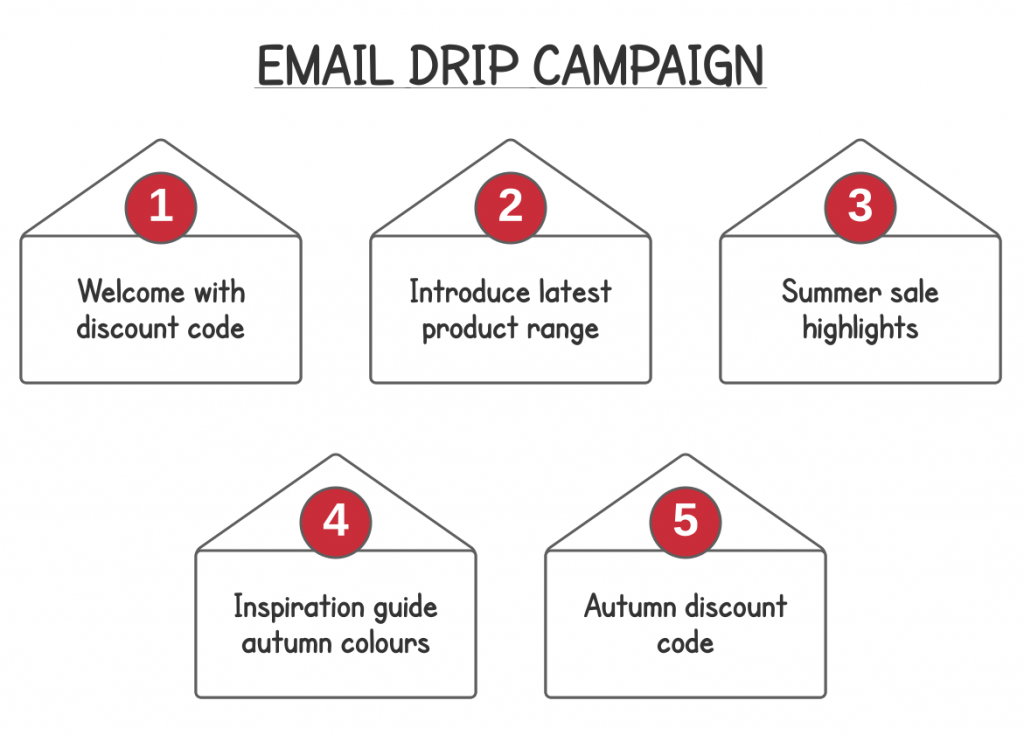
Email open rate
Your open rate shows how many people opened your marketing email as a percentage of the total number of people who received it.
In this example we have 100 subscribers who received the email. Of those 100 subscribers, 70 of them opened the email, meaning that the open rate is 70%.
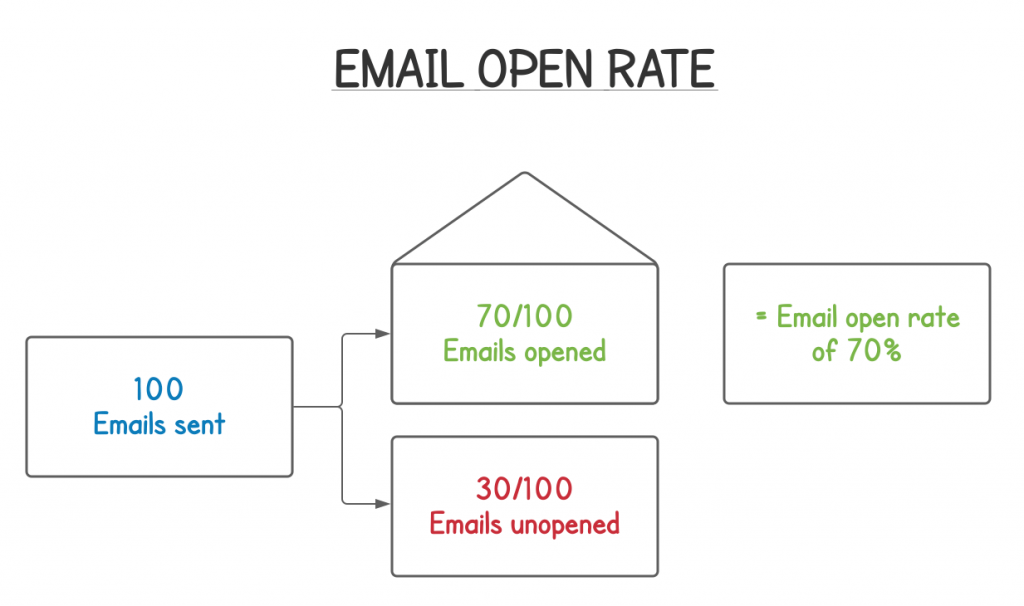
Email sequence
An email sequence is generally an automated email campaign. Unlike drip campaigns, these are targeted more to individuals. The sequences can be triggered by behaviours and events. For example, a sequence might be sent to a subscriber if they:
- Abandoned their shopping cart mid purchase
- Have a birthday or anniversary coming up
- Just made a key purchase or spent a substantial sum.
Engagement rate
Your engagement rate is a new metric introduced in Google Analytics 4 (GA4).
It tracks the number of engaged sessions per user.
An engaged session is a session that:
- Lasts 10 seconds or longer;
- Has one or more conversion events; OR
- Has two or more page views.
The engagement rate has effectively replaced the bounce rate, but it’s a more helpful metric that gives you a clearer picture of how people are using, and getting value from, your website.
Excerpts
The excerpt is the introductory text you see for each article on a main blog page. It should give an enticing summary of the article that will persuade visitors to click on it.
Below is a screenshot of my main blog page. You can see the excerpt for each article highlighted in yellow.
I provide excerpt text with every article I write for my blogging packages.
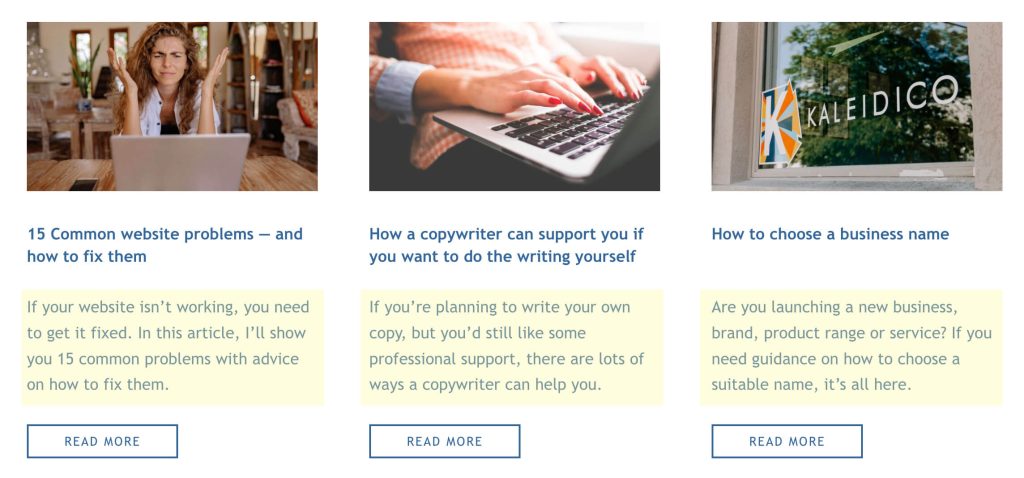
Features
While benefits focus on end results, features focus on how those results are achieved.
Features are important to buyers who understand them and who might want to compare the features of your product with other products on the market.
For example, features might be important to people buying:
- Cars — for engine size, safety features
- Televisions — for screen size, resolution
- Camera equipment — for lens quality and capabilities
- Computers — for processing speed, performance
- Smartphones — for camera, memory, processor.
You can read more about features in my article: Features vs. benefits and how copywriters use them to sell >>
Google Analytics
Google Analytics, now shortened to GA4, is a free tool that measures the performance of your website.
To use it, you need to create an account and implant a snippet of code on each page of your site. When the code is in place, Google can track key metrics, like:
- How many visitors you’re getting
- Where in the world your visitors are based
- Their landing and exit pages
- Which pages they’re viewing
- What keywords they used to find you.
You can view your reports online or have them emailed to you each week.
Most web designers will apply Google Analytics to your website as standard, but if you don’t have it, it’s easy enough to add.
Google Business Profile
If you’re a business that operates in your local area, you’ll be eligible for a free Google Business Profile.
The profile appears on the right hand side of the desktop screen when you do a Google search for your business name. And it will look something like this:
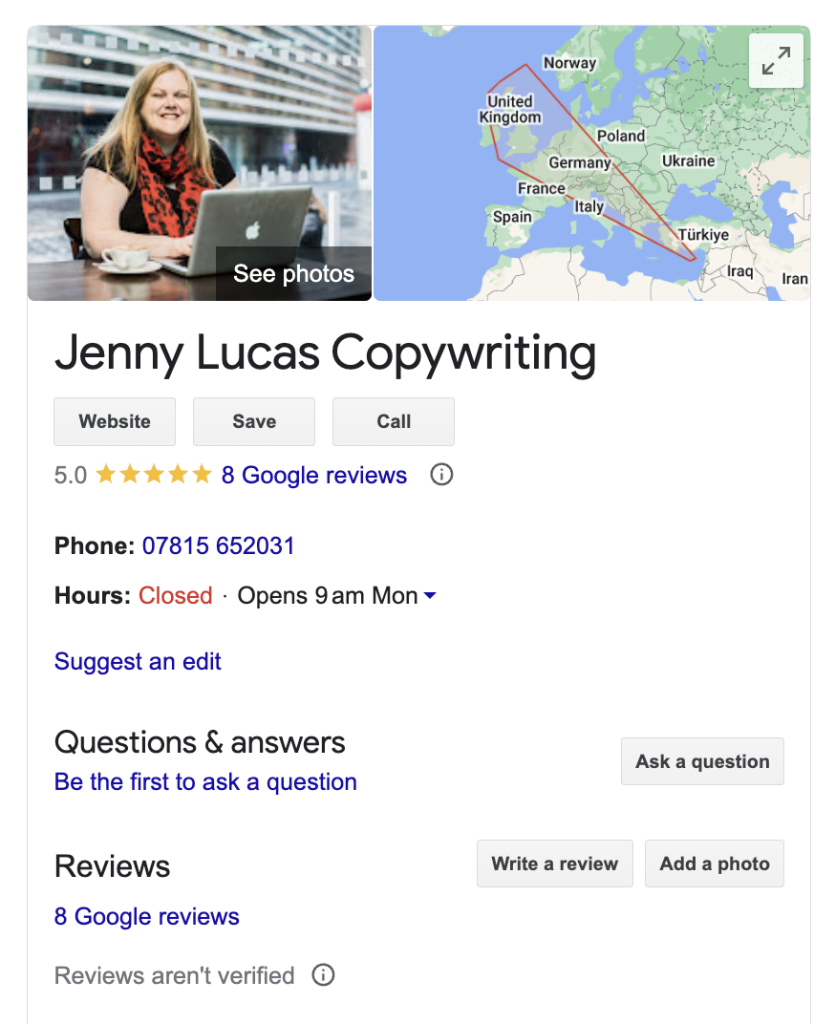
Having a Google Business Profile is good for your SEO. It includes a link to your website, your map location, photographs and customer reviews.
And if you have a new website that isn’t ranking yet, you can use your listing as a mini website, so you have online visibility until it does.
There’s more about Google Business Profiles and how to set them up in my article: How to market your local business online >>
Google Search Console
Like Google Analytics, Google Search Console is a webmaster tool provided by Google. And it also allows you to track how your website is performing and creates data reports.
Search Console is often more useful to SEO copywriters as it’s more focused on keywords. Using your Search Console data, we can see where each page of your site is ranking and what keywords it’s ranking for.
This can be helpful if we’re writing new web copy for you, because it means we know what keywords are already working and can make sure we keep and augment those.
Grey hat SEO
There’s white hat SEO, which is legitimate best practice — i.e. what you should be doing.
Then there’s black hat SEO, which is definitely dodgy and will get you penalised by Google.
And somewhere in the middle, there’s grey hat SEO, which isn’t totally legit, but isn’t a punishable offence — yet.
The ‘yet’ is important. Because it’s my presumption that most black hat SEO techniques probably started out as grey.
My advice with any SEO technique is to always do what seems fair, right and doesn’t seem like a ‘get-to-the-top-of-Google-quick’ scheme.
Headings
Headings are titles used to introduce a new page or new section of copy.
Heading tags
Website and blog headings have a hierarchy from H1 to H6, with H1 being the largest and most important and H6, the smallest and least important.
The heading tag denotes which H-number should be used for each heading on a web page or in a blog article.
When I write your copy, I’ll include a little <h> tag next to each heading. This is just for reference and will be used by your web designer or the person who publishes your blog articles.
You can read all about the heading hierarchy and how to use it here, in my article: How to use the heading hierarchy correctly on your website and blog >>
Hero section
The hero section, also known as the area above the fold, is the portion at the very top of a web page and the first thing a visitor sees when the page loads.
Headline
The headline is the name given to the main heading that appears at the top of a piece of copy. The role of the headline is to introduce the piece as a whole.
Hook
The hook is usually the opening statement of a piece of copy. It’s so called because it hooks your reader in and makes them want to read more.
Ideal client/customer
Every business has an ideal client — even the ones who claim they sell to everyone.
You might say your ideal client works in a specific industry and has a certain job title — but it’s more than that.
For example, there are all kinds of characteristics you might want your ideal client to have, like:
- Being communicative
- Accepting your pricing
- Understanding your role
- Having the right values and attitude
- Paying you fully and on time.
Keywords
When your audience type their search queries into Google, the words they use are known as keywords or SEO keywords. A keyword is usually more than one word and can be up to three words.
It’s your SEO copywriter’s job to research the keywords your audience is using, then implant those keywords into your copy.
The idea is that when someone uses those words to search, your web page will be a match and will show up on Google’s list of search results.
Keyword density
Keyword density is a dated and generally bad SEO strategy. It works on the principle that there’s an ideal ratio of keyword repetition to word count.
Let’s say an agency has given a content writer a blog article to write and they’re using keyword density as their strategy. Their brief will include a word count for the article, a list of keywords and the number of times each keyword should be repeated.
I’ve never used keyword density as a strategy because I write for humans and it always felt unnatural.
Keyword performance
You might hear me me talk about high-performing keywords. A high-performing keyword has three main traits:
- It’s relevant and matches the search intent of your user
- It has an appropriate number of monthly searches
- It has low competition from other websites, meaning it will be easier to rank for.
Keyword relevance
Relevance is one of the most important factors when choosing keywords. They should be relevant to what the searcher is looking for.
When your SEO copywriter does your keyword research, we look up each keyword and check the top ranking sites for that keyword. If those sites are offering the same as yours, we’ll know the keyword is a good one.
Landing pages
A landing page is any web page you land on when you click a link from another source. That could be a Google search, another web page, a marketing email or an online advert.
If you want to create a landing page that works, you can find out how in my article: How to create the perfect landing page >>
Lead magnet
A lead magnet is a great way to introduce new leads to your business.
Most lead magnets are given away for free with an email sign-up. They’re designed to give prospects an idea of what it would be like to work with you.
Examples of lead magnets include:
- Ebook
- Mini course by email
- 5-Day challenge
- Cheat sheet or template
- Webinar.
Long-tail keywords
Long-tail keywords are what your audience might use when they want to do a Google search for something very specific.
A long-tail keyword is a proper phrase and not several+keywords+joined+with+plus+signs.
While a standard keyword search typically contains up to three words, a long-tail keyword search contains more.
For example:
Standard keyword search: Plumber Nottingham
Long-tail keyword search: Emergency plumber and drain specialist Nottingham
Long-tail keywords can be advantageous because they often have low competition and can contain several standard keywords, too.
Meta descriptions/meta tags
Meta descriptions are a component of your on-page SEO. They don’t appear on your website, but you can see them when you do a Google search. They’re the two black lines of text under your blue page title.
Your meta descriptions can contain SEO keywords, but their main purpose is to give searchers an introduction to what’s on your page and entice them to visit your website.
You should have a different meta description for each page of your website. Here’s how my home page meta description looks on the Google search engine results page:

Monthly searches
If we’re going to use a keyword on your website, it should be one that people are actually using.
When I talk about monthly searches, I’ll be referring to the average number of times a keyword has been searched for over the last 12 months.
Outro
In publishing, the outro is the closing statement at the end of a piece. The piece could be a poster or an ad campaign. For example, the outro of this poster is the line: Kill your speed before your speed kills.
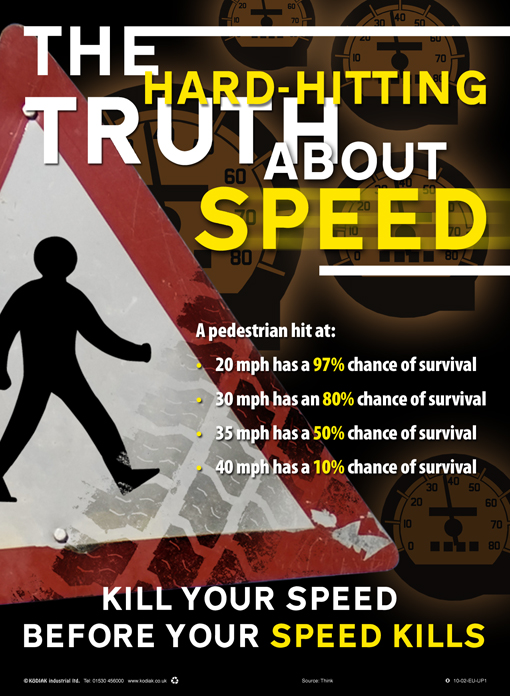
Page titles/title tags
Each page of your website should have a unique page title. A relevant page title with high-performing keywords is vital to your on-page SEO.
Like the meta description, it doesn’t appear on your website, but you can see it when you do a Google search.
It’s the large blue line of text that appears under your URL. You can see mine here:

You also get a glimpse of your page title on the tab in your browser. Here’s how mine appears in Chrome:
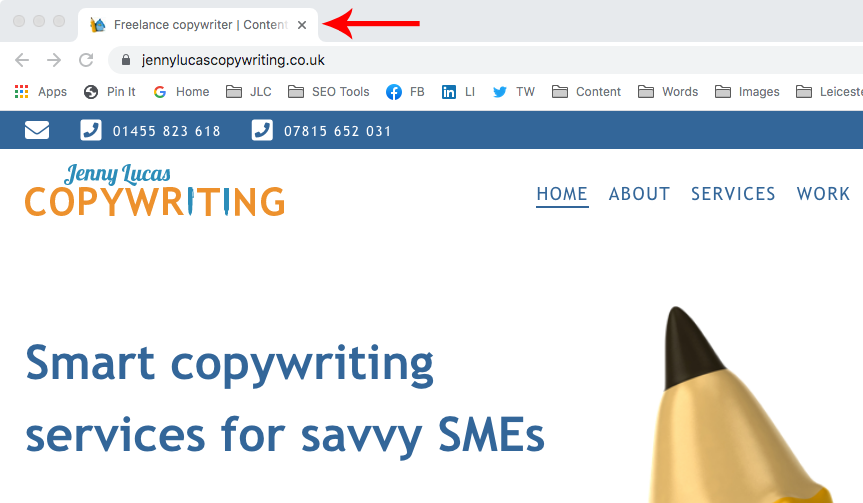
Pain points
We talk about pain points a lot — especially when we’re writing sales copy.
The pain point is what’s causing the reader to have a problem. For example, it might be something that’s:
- A source of tension, frustration or irritation
- Costing an excessive amount of money
- Taking too much time and/or energy
- Clunky or overcomplicated.
Where there’s a pain point, the aim of the copy is to describe that pain point, then swoop in with the product or service that will relieve it and make it go away.
Passive voice
Passive voice describes the grammatical construction of a sentence of piece of copy.
It’s not always advisable to use it in conversational copy, because it sounds too formal and detached.
The opposite of passive voice is active voice, which is clearer and more direct.
You’ll find a full discussion about both, with examples, in my article: Passive voice vs active voice >>
Pillar content
Content marketing strategies typically include a number of pillars (categories) around which the content is based.
Pillar content refers to articles that fit inside those categories.
Pillar articles are articles that are designed to link all your pillar content together.
Prospects
Prospects are sales leads that you’ve already qualified. In other words, they fit the profile of your ideal client/customer and they’ve shown an interest in your business.
They might also be referred to as a warm or hot sales lead.
Copywriting for them might include:
- Blog content (informational, educational, sales)
- Buyer guides
- Email sequences (for sign-ups)
- Paid lead magnets.
Sales or marketing funnel
A sales funnel is used to map out the journey someone will go through from cold sales lead to paying customer.
The typical sales funnel looks something like this:
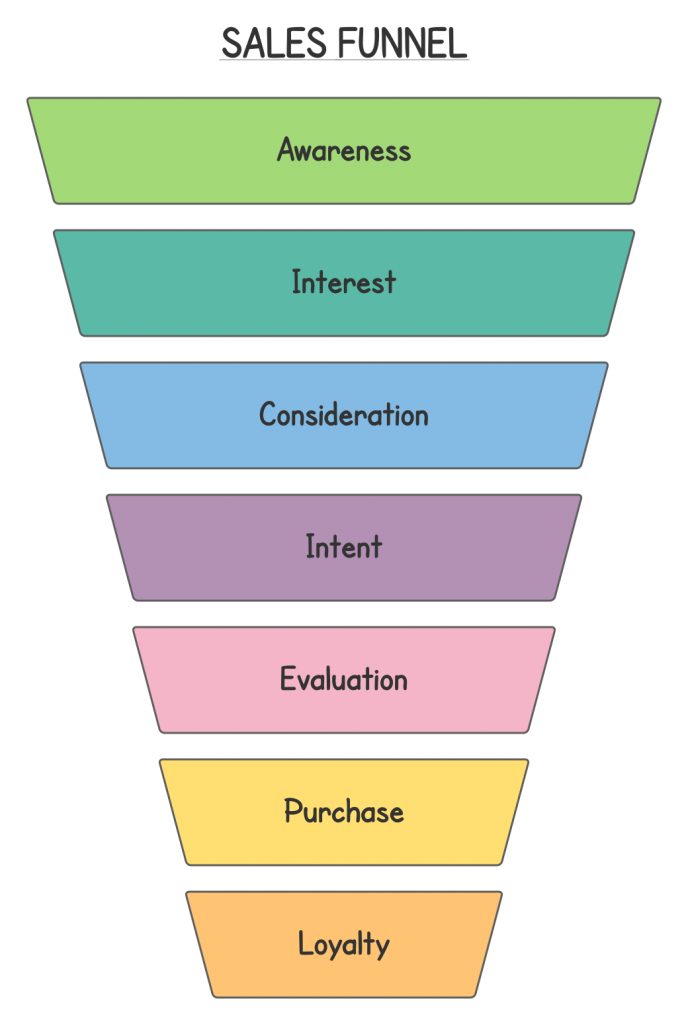
Awareness
A cold lead becomes aware of your business. They might see you in the press, come across your post on social media, find your website via SEO or meet you in person at an event.
Interest
Once aware, the lead becomes interested. They might do some research on your website, read your blog articles, look at your case studies and check out your testimonials. The lead can now be considered a prospect.
Consideration
The prospect is interested, but they’re still considering their options and are not quite ready to buy yet. At this stage they might be open to a free lead magnet, such as an ebook, webinar or downloadable cheat sheet.
Intent
When they’ve considered the benefits of buying from you or working with you, your prospect will show their intent. They might go through your customer sign-up or contact you to arrange a discovery call. You should make this easy for them.
Evaluation
The intent is there, but it’s the sales process or discovery call that will finally seal the deal. Make it smooth and pain-free so you don’t give them cause to change their mind.
Purchase
This is the point where money changes hands. They’ll complete their transaction or pay you a deposit for your services.
Loyalty
If they’ve made their purchase and had a good experience, they’ll be more likely to buy from you or work with you again — and more likely to recommend you to others. You can help to build loyalty with good aftercare and by keeping them engaged with marketing communications, new products, special offers and loyalty schemes.
Sales leads
Sales leads are people who you haven’t yet qualified.
There are three kinds of sales lead and they’re categorised by temperature:
Cold leads ❄️
Cold leads are people who are encountering your business for the first time. For example, they might be a person who’s visiting your website or comes across your blog article.
At this point, these leads are unqualified. But there may be an opportunity to warm them up!
Copywriting for cold leads might include:
- Blog content (answer questions, offer advice)
- SEO copy and content (to attract)
- Social media posts
- Free lead magnets.
Warm leads ☀️
Warm leads are prospects who have encountered your business and shown an interest in it. For example, they might have joined your mailing list, downloaded your lead magnet or attended your webinar.
Hot leads 🔥
Hot leads are prospects who are acquainted with your business and have indicated that they might be ready to buy from you. For example, they may have arranged a preliminary meeting, discovery call or showroom visit.
Sales letter/page
A sales letter is a letter that’s written to a lead, prospect or existing customer with the purpose of selling them something.
A sales page is any page of your website that’s written for the purpose of selling.
Search intent
Search intent is the main goal a user has when they search for something online.
For example, Google has determined that users searching for ‘carrot soup’ are looking for carrot soup recipes rather than anything else.
Our aim, therefore, is to match your SEO copy to the search intent of your user.
SEO: Search Engine Optimisation
SEO is about optimising your website so it performs well in the search engine listings.
There are many components that make up an effective SEO strategy, but most SEO copywriters are mainly concerned with:
- On-page SEO (as opposed link-building from other sites)
- Finding relevant, high-performing keywords
- Demonstrating E-E-A-T (Experience, Expertise, Authority and Trust)
- Formatting your pages for optimum performance.
SEO is a broad subject to cover in detail here, but you’ll find all the other articles I’ve written in the SEO section of my blog >>
SERP: Search Engine Results Page
When we talk about the SERP, we’re talking about the list of website results you get from your search engine when you’ve typed in a search term.
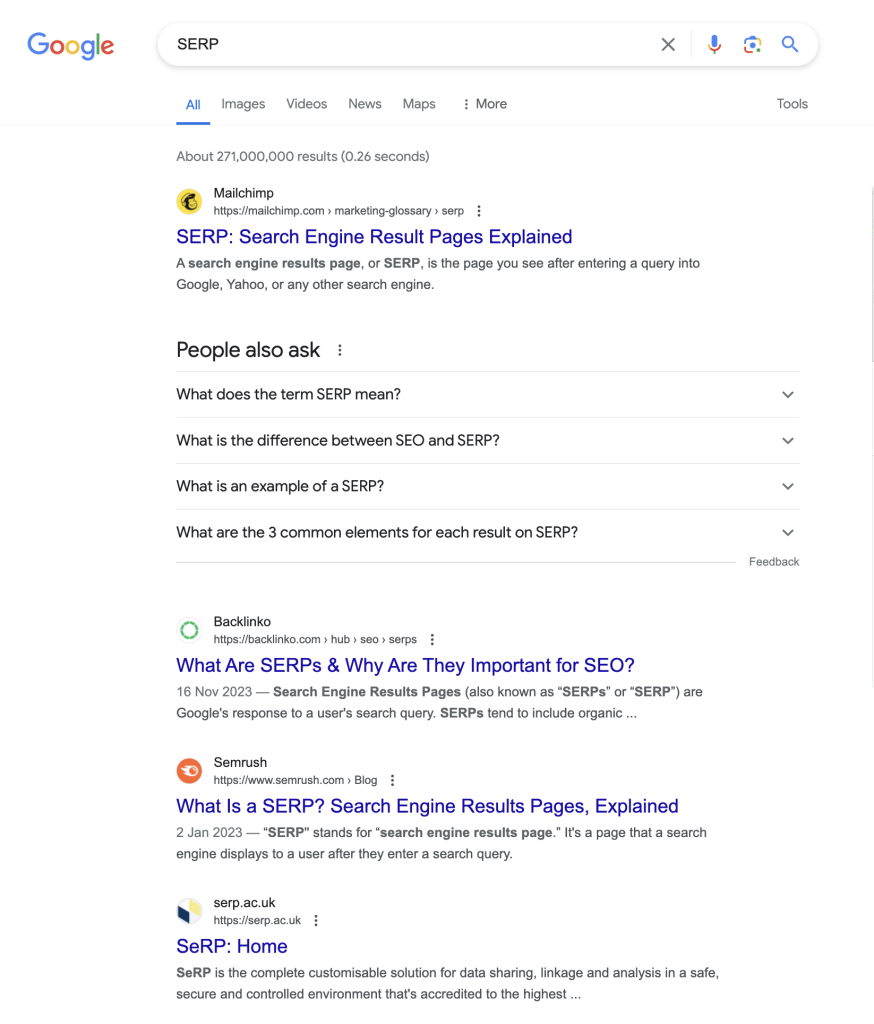
Social proof
Social proof is confirmation from your clients/customers that helps to prove your product is as good as you say.
Examples of social proof include:
- High star-ratings on independent review sites
- Testimonials from happy customers
- Positive social media reviews/recommendations
- Compelling results of customer surveys.
Strapline/tagline
The strapline or tagline appears after a brand’s name. Its purpose is to sum up the brand’s identity, culture and personality in just a few words.
Examples of famous straplines include:
- (Nike) Just do it
- (Ikea) The wonderful every day
- (John Lewis) Never knowingly undersold
- (L’oréal) Because you’re worth it
- (Apple) Think different.
Target market
Your target market is the name for the section of people you want to sell to and who are the best match for your product/service.
Your target market can be defined by a range of criteria, including things like their:
- Demographics (age, gender, location etc.)
- Personal circumstances
- Professional status
- Lifestyle choices
- Preferences.
Testimonials
A testimonial or review is a statement made by a customer or client in which they talk about what they bought from you and the experience they had.
Their testimonial might include reference to the:
- Product/service (how good it is and whether it’s as described)
- Customer service (how well they were treated)
- Buying experience (how easy/user-friendly it was)
- Delivery (whether it was on time and in good condition).
Tone deaf messaging
We might say a brand’s message is tone deaf if it seems they’re not listening or reading the mood in the room. And if, consequently, they write something that seems uninformed, insensitive or offensive.
Typo
Typos usually happen when a copywriter’s brain is working faster than their fingers can type. And they might, for example, spell a word wrong, miss out a letter/word, or get the letters transposed.
This is why we proofread our work and encourage you to be vigilant, too.
URL: Uniform Resource Locator
Each page of your website has its own unique URL.
This is the full address of your website with the https://www. at the front.
USP: Unique Selling Proposition
Your USPs are the things that make you different to your competitors and more appealing to your target market.
Note that I said ‘different’ and not just ‘better’. Because ‘better’ can be replicated, but ‘different’ can’t — at least not so easily.
It doesn’t have to be your product or service that’s different. It could be your:
- Brand values
- Commitment to a cause
- Approach to customer service
- Strengths in a particular area.
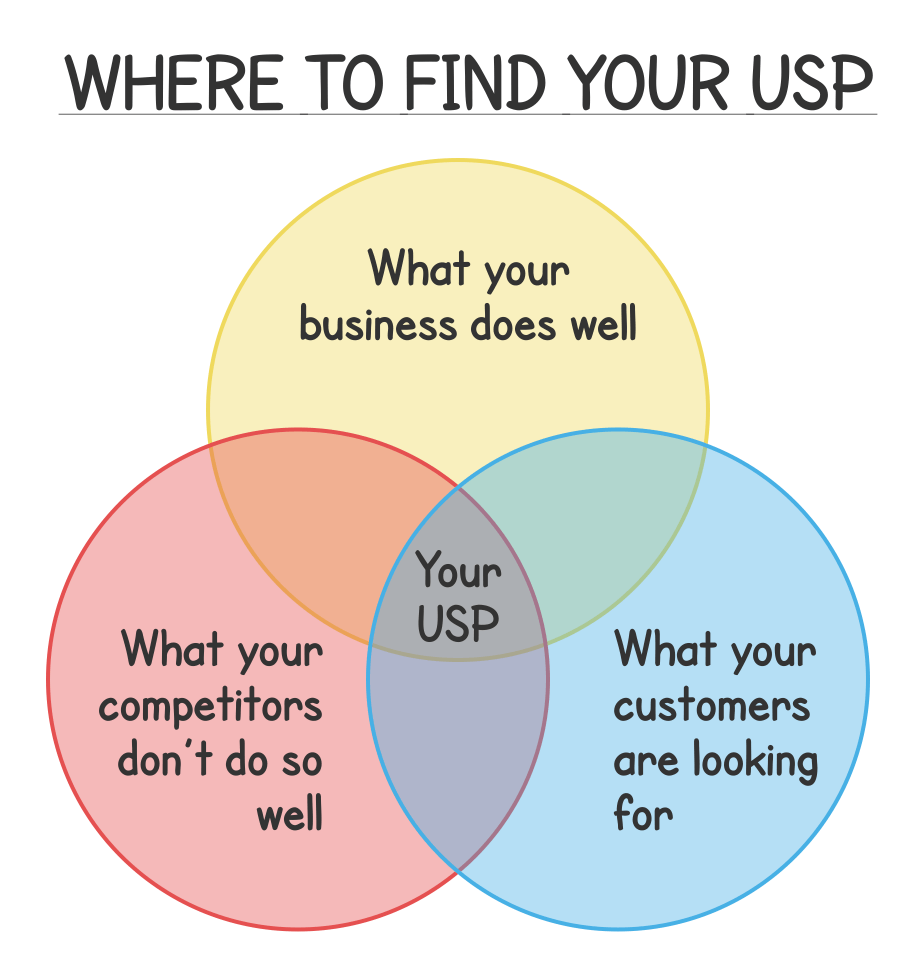
You can read more about USPs in my article: How to make your brand more unique >>
Upselling
Upselling is where you persuade a prospect/customer to buy something of a higher value than they were originally planning to. Or where you persuade a customer who’s just bought from you to buy something further.
For example, where a prospect is thinking of buying your entry level package, but you convince them that the intermediate package would suit their needs better.
Or where a customer has added a base product to their cart, so you show them the optional add-ons and peripherals that would make their experience of that product even better.
UX: User eXperience
To put it simply, UX is the experience your user has when they interact with your company or your website.
UX should be carefully considered when you’re putting together anything that your user will interact with. For example:
- Site navigation and signposting
- Processes, such as sign-ups and transactions
- Clear, user-friendly design
- Instructional copy that tells users what to do
- Automated telephone processes
- Consistency and continuity.
I’ve written several full articles that talk about UX in more detail in the UX section of my blog >>
Value proposition
Your value proposition is a simple statement that explains why your prospects would choose your product or service over your competitors. It should be something that makes you different to your competitors, and not just better than them.
You can read more about value proposition in my article: How to make your brand more unique >>
Voice of customer
You might hear me talk about something called ‘voice of customer research’.
This involves researching your customers online and looking at the words and language they’re using when they talk about your products or services.
Voice of customer research gives copywriters insight about what’s important to your ideal customers, so we know what to talk about in your copy.
And understanding your ideal customers’ language is vital for producing effective SEO copy, because this is the language they’ll use when they search for businesses/products/services like yours.
Waffle
Here’s a word I use a lot. You waffle when you use a lot of unnecessary words without saying or adding anything of value.
Waffle tends to appear on the page when you:
- Runs out of things to say before you hit your word count
- Don’t fully understand what you’re writing about
- Haven’t read through and edited your copy.
You may be reassured to know, I have a no-waffle policy when it comes to writing copy and content.
White hat SEO
White hat SEO is the good kind of SEO. It refers to approved and legitimate ways of optimising your website and content so your website functions well and appears higher in Google’s search results.
Anything I’ve missed?
If there’s something your copywriter has talked to you about and you can’t see it here, you can let me know by sending me a contact form or messaging me on social media. You’ll find the form and all the links on my contact page.
You might also like…

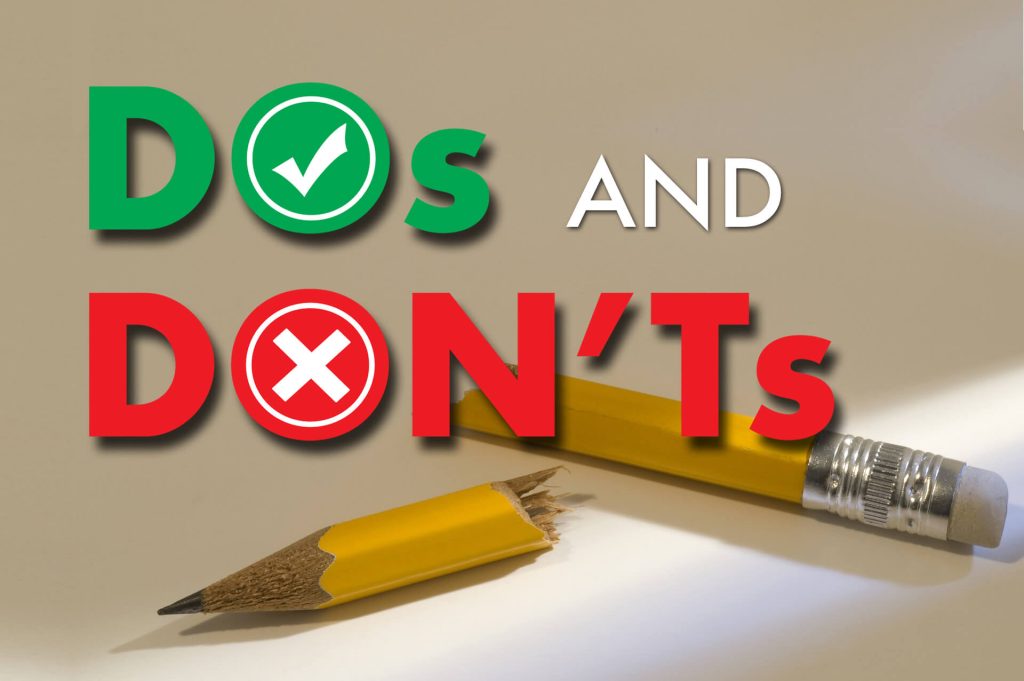

Need a copywriter?
Allow me to introduce myself.
I’m Jenny Lucas, a freelance copywriter and content writer based in Leicester.
As a generalist copywriter, I write on a wide range of subjects. And I specialise in SEO copy and content for the web.
You can find more information about me, the services I offer and what it’s like to work with me on my website or blog.

